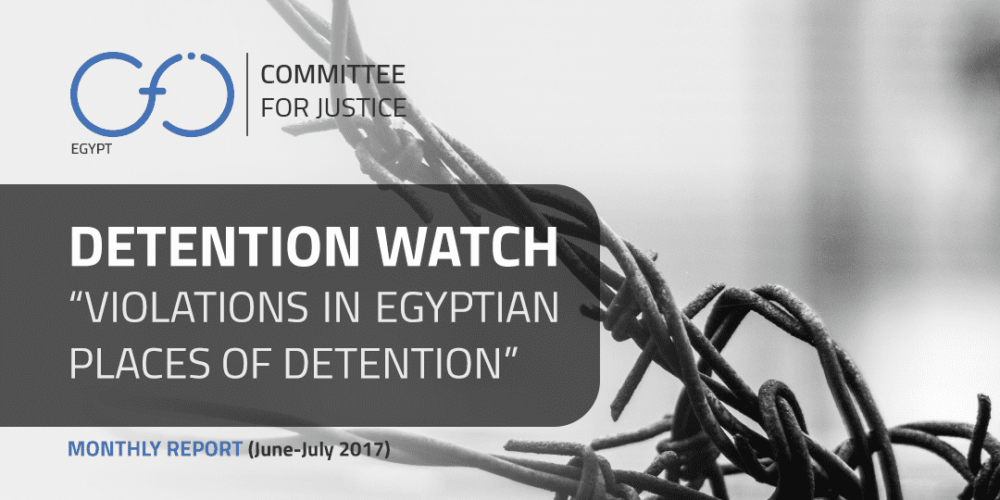Following CfJ’s first reports on human rights violations against detainees in Egyptian detention places for the first months of 2017,(Jan-Feb),(March-April) and (May) Detention Watch project proceeds in this issue to provide an analytical overview of the human rights situation in Egyptian detention places – formal and informal – during the month of June and July 2017; while holding the authorities accountable of their obligations mandated by law (Egyptian constitution, Egyptian criminal law, and international human rights treaties Egypt has signed).
- The end objective of such periodic reports is to:
- inform national and international stakeholders of the ongoing conditions inside places of detention,
- enable families of victims and detainees to factually establish claims of illegal and inhumane circumstances that are endured,
- engage or demand engagement of authorities into a dialogue that can formulate coherent and consistent strategies and legislations that put an end to such violations,
- support prevention of impunity of human rights violations in places of detention,
- contribute to the transitional justice mechanisms that this country will or might employ at a later stage
The methodology of this activity primarily entailed monitoring and observing violations being reported formally and informally on a day-to-day basis. After collecting the primary data, the project team employed the verification tool; a step that is regrettably overlooked by many other human rights organizations reporting in the same field due to difficulties establishing contact, time consumption and risks associated. Authenticating the data collected is a crucial step to safeguard the credibility of the data presented, and to be able to legally hold the violators accountable with proof. Accordingly, it was imperative for Detention Watch to communicate with the families of each detainee who suffered a violation and verify all the information needed. All the gathered data whether monitored or verified were finally compiled in this report with a contextual and statistical analysis; while shedding light on the challenges and limitations handled while working on the material.
Key findings that Detention Watch reached can be summarized as follows:
- In June 2017, 195 cases of violations were monitored while 217 violations were monitored in July 2017.
- Out of the 195 cases in June, 77.9% rate of enforced disappearance was recorded, 16.9% rate of medical negligence, 4.6% rate of torture and 0.5 rate of death due to medical negligence.
- In June, Sharqia Governorate is responsible for 36 of the monitored enforced disappearance cases or 23.6% of all the cases. Followed by, Cairo Governorate with 14 cases at 9.2% of cases.
- Out of the 217 cases in July 2017, 87.5% rate of enforced disappearance, 7.4% rate of medical negligence, 3.7% rate of torture, 1.3% rate of death due to medical negligence, 0.4% rate each to death due to torture and death as a result of suicide.
- In July, Sharqia Governorate has again the highest number of reported enforced disappearance case with 36 cases at a rate of 19%. Followed by, Giza governorate with 25 reported cases at 13.2%.
- On the 27 cases reported, 66 violations were accounted (each violation a victim suffered was counted as one entry, even when a victim suffered several violations, see explanation in methodology)
- Medical negligence and torture both account for 44% of verified violations while enforced disappearance accounts for 8 cases or 12%.
- Wadi Natroun Prison 440, Qasr El Nil Police Station, Tora Prison and State Security Zagizag are responsible for the highest number of verified violations with each accounting to 7.5% of total verified violations.
- the prisons category accounts for 56% of total number of violations. Followed by State Security Premises with 18.1% and Police Station with 15% of verified violations.
- 22 detainees out of the 27 detainees were subjected to enforced disappearance amounting to 81% of total number of detainees.
- When the location is known, enforced disappearance almost always happen in informal detention places accounting for 83.3% of known detention places for enforced disappearance victims.
- Gamzah Prison and Wadi Natroun 440 Prison have the highest number of medical negligence violations amounting to 10.3% each of total number of medical negligence violations.
- 80% of detainees facing medical negligence have spent two or more years in detention; which shows us an underlying positive correlation between time spent in detention and possibilities of deteriorating health conditions that are faced with negligence.
- 79% of the total number of detainees (11 out of 14 detainees) who suffered from medcial negligence have also been subjected to torture. These two types of violations are often linked as one of the consequences of torture is a deteriorating health.
- While torture is committed almost equally in prisons and State Security Premises. The Prison category comes first with 14 documented incidents of torture amounting to 48.2% of total verified torture incidents.
- The most targeted age group is youth (16 – 30) with 44% of victims, followed by the middle-age group (31 – 50) 30%, then finally the elderly (above 50) 26%. The same conclusions were drawn from the previous reports.
- As observed in May, more than half of the victims of violations (56%) didn’t go into court yet; are held pre-trial. The rest remain post-trial detainees.






